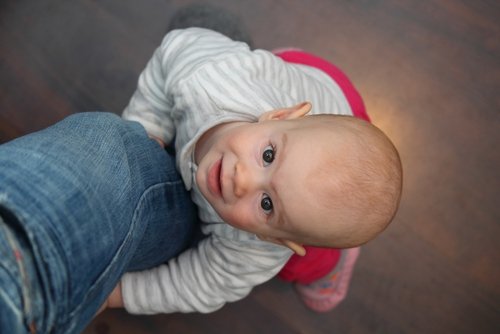Anxious-Avoidant Attachment and Its Characteristics

Anxious-avoidant attachment in children refers to a suppression of emotions towards their parents or other adults responsible for their care. This suppression is the result of children feeling that they don’t receive attention or expected responses from their caregivers.
As a result, these children maintain a position of self-sufficiency and independence with regard to their need for attention and external bonds, even love.
Feelings of attachment are present in children, adults, and other mammal species as well. This condition allows children to, among other things, develop a sense of security and stability.
This is almost like a survival instinct. It’s also fundamental for creating social connections.
Anxious-avoidant attachment in children and its characteristics
Characteristics of children with anxious-avoidant attachment
According to the attachment theories developed by Mary Ainsworth, the creation of bonds of love and dependence form within individuals from an early age. These bonds are healthy for human beings, given that we’re social beings.
However, some children perceive that those around them don’t respond in a positive way or feel constantly rejected. This can occur with their parents or any other close caregiver.
These children develop a feeling of independence that drives them to suppress their desire to ask for help, protection or affection.
They learn from a very young age that the relationship they maintain with those who are supposed to protect them is a frustrating one.
As a result, they literally adopt an attitude of not feeling affected – neither positively nor negatively – by the presence, absence or assistance of their parents.
In some of the research cases performed by Ainsworth, for example, children avoided crying to ask for food or help. They did so in order to avoid being rejecting by their parents and to be able to stay close to them in the same room.
These children also open up and are more receptive to communicating and connecting with those outside of their inner circle. Therefore, they come off as friendly to strangers.

Symptoms of anxious-avoidant attachment in children
Children with anxious-avoidant attachment display certain attitudes in their behaviors that allow us to identify them. Some of these expressions include:
- Come off as isolated and tend not to give off many expressions of affection.
- May be hostile with their classmates or others in their environment.
- Children with anxious-avoidant attachment are more likely to bully their classmates.
- Feel uncomfortable with physical contact, such as hugs and kisses.
- Feel disdain towards their teachers.
- Are prone to frequent tantrums.
- May seem to have a high self-esteem, which comes along with a feeling that others are inferior.
“Attachment allows children to – among other things – develop a sense of security and stability. This is almost like a survival instinct. It’s also fundamental for creating social connections”
Treatments for anxious-avoidant attachment in children
It’s important to identify if a child has anxious-avoidant attachment. People with this type of attachment present serious difficulties when it comes to forming affectionate bonds as adults.
What’s even more unfortunate is that, they may produce this same type of attachment in their children, if they have any.
The therapies for treating this type of attachment concentrate on trying to identify the source – in other words, the origin of the experiences that caused a person’s need to suppress his or her feelings.
Then, therapists help patients recognize the reason behind these events and encourage them to let go of their resulting sadness.

After identifying the causes, therapists lead children in exercises that help them feel comfortable being vulnerable. These exercises are aimed at helping children to learn to trust other people without fearing rejection or failure.
Psychologists who treat children with anxious-avoidant attachment will also try to exhaustively reduce anxiety levels.
Children may experience anxiety both consciously or unconsciously. And this anxiety keeps them in a state of constant alert and tension regarding connections and interactions with others.
Anxious-avoidant attachment is a condition that produces a great deal of frustration when it comes to social interaction. Unfortunately, children who experience this attachment disorder often deal with the effects well into adulthood.
If you identify one or more of these characteristics in your child, we recommend becoming more informed and requesting a professional consult as soon as possible.
Anxious-avoidant attachment in children refers to a suppression of emotions towards their parents or other adults responsible for their care. This suppression is the result of children feeling that they don’t receive attention or expected responses from their caregivers.
As a result, these children maintain a position of self-sufficiency and independence with regard to their need for attention and external bonds, even love.
Feelings of attachment are present in children, adults, and other mammal species as well. This condition allows children to, among other things, develop a sense of security and stability.
This is almost like a survival instinct. It’s also fundamental for creating social connections.
Anxious-avoidant attachment in children and its characteristics
Characteristics of children with anxious-avoidant attachment
According to the attachment theories developed by Mary Ainsworth, the creation of bonds of love and dependence form within individuals from an early age. These bonds are healthy for human beings, given that we’re social beings.
However, some children perceive that those around them don’t respond in a positive way or feel constantly rejected. This can occur with their parents or any other close caregiver.
These children develop a feeling of independence that drives them to suppress their desire to ask for help, protection or affection.
They learn from a very young age that the relationship they maintain with those who are supposed to protect them is a frustrating one.
As a result, they literally adopt an attitude of not feeling affected – neither positively nor negatively – by the presence, absence or assistance of their parents.
In some of the research cases performed by Ainsworth, for example, children avoided crying to ask for food or help. They did so in order to avoid being rejecting by their parents and to be able to stay close to them in the same room.
These children also open up and are more receptive to communicating and connecting with those outside of their inner circle. Therefore, they come off as friendly to strangers.

Symptoms of anxious-avoidant attachment in children
Children with anxious-avoidant attachment display certain attitudes in their behaviors that allow us to identify them. Some of these expressions include:
- Come off as isolated and tend not to give off many expressions of affection.
- May be hostile with their classmates or others in their environment.
- Children with anxious-avoidant attachment are more likely to bully their classmates.
- Feel uncomfortable with physical contact, such as hugs and kisses.
- Feel disdain towards their teachers.
- Are prone to frequent tantrums.
- May seem to have a high self-esteem, which comes along with a feeling that others are inferior.
“Attachment allows children to – among other things – develop a sense of security and stability. This is almost like a survival instinct. It’s also fundamental for creating social connections”
Treatments for anxious-avoidant attachment in children
It’s important to identify if a child has anxious-avoidant attachment. People with this type of attachment present serious difficulties when it comes to forming affectionate bonds as adults.
What’s even more unfortunate is that, they may produce this same type of attachment in their children, if they have any.
The therapies for treating this type of attachment concentrate on trying to identify the source – in other words, the origin of the experiences that caused a person’s need to suppress his or her feelings.
Then, therapists help patients recognize the reason behind these events and encourage them to let go of their resulting sadness.

After identifying the causes, therapists lead children in exercises that help them feel comfortable being vulnerable. These exercises are aimed at helping children to learn to trust other people without fearing rejection or failure.
Psychologists who treat children with anxious-avoidant attachment will also try to exhaustively reduce anxiety levels.
Children may experience anxiety both consciously or unconsciously. And this anxiety keeps them in a state of constant alert and tension regarding connections and interactions with others.
Anxious-avoidant attachment is a condition that produces a great deal of frustration when it comes to social interaction. Unfortunately, children who experience this attachment disorder often deal with the effects well into adulthood.
If you identify one or more of these characteristics in your child, we recommend becoming more informed and requesting a professional consult as soon as possible.
All cited sources were thoroughly reviewed by our team to ensure their quality, reliability, currency, and validity. The bibliography of this article was considered reliable and of academic or scientific accuracy.
- Barudy, J., & Dantagnan, M. (2005). Los buenos tratos a la infancia: Parentalidad, apego y resiliencia. Editorial Gedisa.
- Garrido-Rojas, L. (2006). Apego, emoción y regulación emocional. Implicaciones para la salud. Revista latinoamericana de psicología, 38(3), 493-507. https://www.redalyc.org/pdf/805/80538304.pdf
- Marrone, M., Diamond, N., Juri, L., & Bleichmar, H. (2001). La teoría del apego: un enfoque actual. Madrid: Psimática.
- Mosquera D, Gonzalez, A (2009) Escala de Apego y Patrones Relacionales.
- Mosquera, D., & González, A. (2013). Del apego temprano a los síntomas del trastorno límite de personalidad. Revista Digital de Medicina Psicosomática y Psicoterapia, 3(3), 1-33. http://www.psicociencias.com/pdf_noticias/Apego_y_TLP.pdf
- Shaffer, D. R., & del Barrio Martínez, C. (2002). Desarrollo social y de la personalidad. Madrid: Thomson.
This text is provided for informational purposes only and does not replace consultation with a professional. If in doubt, consult your specialist.








